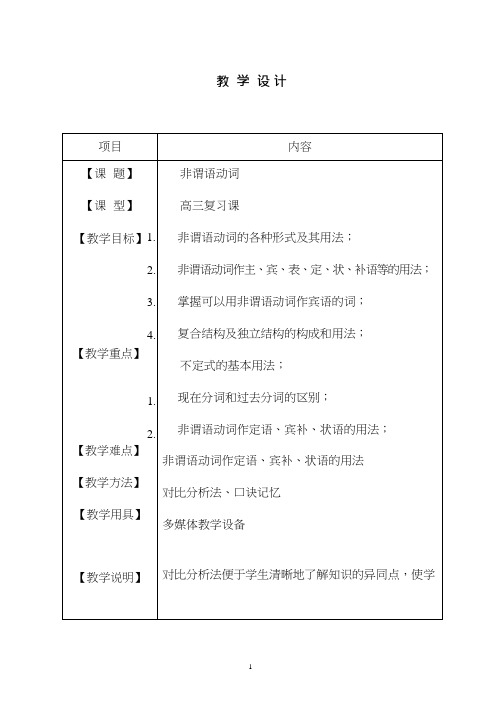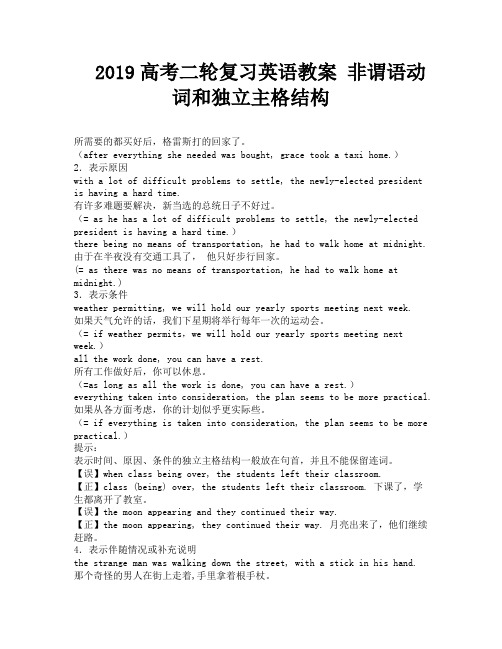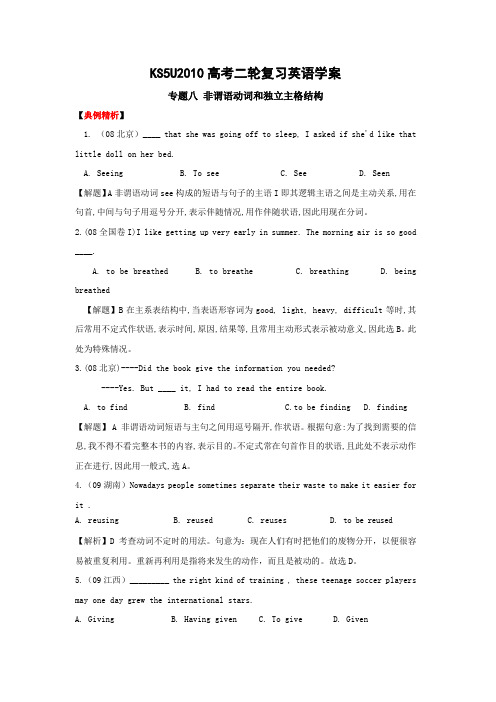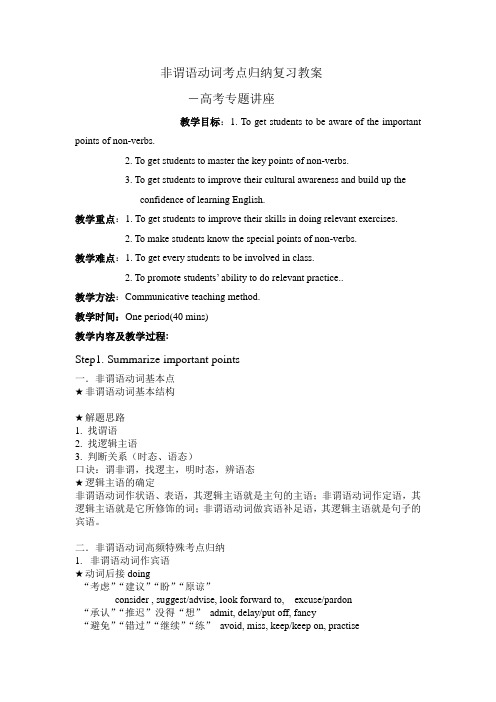高考英语二轮复习 非谓语动词和独立主格结构精品教案1
高中英语《非谓语动词》优质课教案、教学设计

教学设计生能够从整体上把握知识脉络。
通过口诀记忆,使学生快速掌握,不容易遗忘。
在教学过程中,通过提问、启发等方式师生共同完成知识脉络,以达到较牢固的记忆及较理想的复习效果。
非谓语动词经常出现在高考题的语法填空、短文改错中,教学过程中的精选习题有助于学生及时地更好地掌握这部分语法知识。
【教学过程】课前预习(12 个单句语法填空)设计意图:通过练习,总结非谓语动词的形式,使学生对本节课的内容有大概的了解。
一、高考考纲解读近三年高考主要考查非谓语动词的作用和形式。
在作用方面主要考查作宾语时用不定式还是动名词;作宾语、状语、补语时用不定式还是分词;它们作某一成分时的特殊情况及特殊结构。
在形式方面主要考查用一般式还是完成式、主动式还是被动式、现在分词还是过去分词。
设计意图:使学生明确教学大纲的要求,了解其在考试中的重要性。
二、非谓语动词考点(二轮复习专家解读)1.不定式作宾语与动词的-ing 形式作宾语的区别2.不定式作宾补vs.分词作宾补的区别3.不定式作状语和分词作状语的区别4.不定式、现在分词和过去分词作定语的区别5.不定式的主动式和被动式作定语的区别6.动名词的复合结构作宾语时的代词转化7.带to 不定式和不带to 不定式8.不定式符号的单独使用设计意图:使学生细化知识点,掌握重难点。
三、非谓语动词思维导图及图表结构(结合时态和语态)设计意图:运用思维导图,一目了然,帮助学生有效记忆。
四、非谓语动词的句法功能归纳考点一非谓语动词作状语1.动词不定式作状语2.分词作状语3.独立成分作状语易错警示某些动词的过去分词已经形容词化,且常用于一些系表结构中,此时这些过去分词只表示一种状态,作状语时不表示被动关系,其前不用being。
语法训练吧:1.As the light turned green ,I stood for a moment ,not ,and asked myself what I was going to do.A.moved B.moving C.to move D.being moved2.an important role in a new movie,Andy has got a chance to become famous.A.Offer B.Offering C.Offered D.To offer考点二非谓语动词作定语1.过去分词作定语:2.现在分词作定语:3.动词不定式作定语:4.现在分词与动名词作定语的区别:语法训练吧:1.The idea you thought of a bridge over the river there sounds reasonable.A.build B.to build C.building D.built2.The ability an idea is as important as the idea itself.A .expressingB .expressedC .to expressD .to be expressed考点三非谓语动词作补语1.感官动词(词组)“一感”:f ee l“二听”:h ea r,li ste n to“五看”:see, watch, notice, observe, look at +宾语+1) 不带to 的不定式(表示主动和完成)2)现在分词(表示主动和正在进行)3)过去分词(表示被动和完成)2.make +宾语+do “让…做…”(与宾语为主动关系)make +宾语+done“让…被做”…”(与宾语为被动关系)3.let +宾语+do “让…做…”(与宾语为主动关系)let +宾语+be done“让…被做…”(与宾语为被动关系)4.have +宾语+do sth. 使…做某事have +宾语+doing sth. 使…持续做某事have+宾语+done 使…被做(宾语与宾补为逻辑上的被动关系)have sth. to do 有事要做(不定式作定语)注:have + sb. +doing 若用于否定句,不能容忍或不允许某人做某事。
高考英语二轮复习非谓语独立主格结构课件(25张)

3._____ a great leader, his words carry more weight than anybody else’s.
A. Being
B. He is
C. For he is
D. He being
练习
4.There are various kinds of metals, each____ its own properties.
A. them
B. which
C. that
D. whom
11.He wrote a lot of novels, none of _____ translated into a foreign language.
A. them
B. which
C . it
Hale Waihona Puke D. what12.The growing speed of a plant is influenced by a number of factors, most of _____ are beyond our control.
4.More time and money __g_i_v_e_n_(give) , we can finish the work in
advance.
条件状语
△正在讨论这个问题时,他想出了一个实际的解决方法。
The question _b_e_in_g__d_is_c_u_ss_e_d___(discuss), he came up with a practical
2.If time permits, I will go with you. 条件状语从句 独立主格:__T_im_e__p_er_m_i_tt_in_g______, I will go with you. 3.As the girl stared at him, he didn’t know what to say. 时间状语从句 独立主格:__T_h_e_g_ir_l_st_a_ri_n_g_a_t_h_im__, he didn't know what to say.
2019高考二轮复习英语教案 非谓语动词和独立主格结构-11

2019高考二轮复习英语教案非谓语动词和独立主格结构所需要的都买好后,格雷斯打的回家了。
(after everything she needed was bought, grace took a taxi home.)2.表示原因with a lot of difficult problems to settle, the newly-elected presidentis having a hard time.有许多难题要解决,新当选的总统日子不好过。
(= as he has a lot of difficult problems to settle, the newly-elected president is having a hard time.)there being no means of transportation, he had to walk home at midnight. 由于在半夜没有交通工具了,他只好步行回家。
(= as there was no means of transportation, he had to walk home at midnight.)3.表示条件weather permitting, we will hold our yearly sports meeting next week.如果天气允许的话,我们下星期将举行每年一次的运动会。
(= if weather permits,we will hold our yearly sports meeting next week.)all the work done, you can have a rest.所有工作做好后,你可以休息。
(=as long as all the work is done, you can have a rest.)everything taken into consideration, the plan seems to be more practical. 如果从各方面考虑,你的计划似乎更实际些。
高三英语高考二轮复习学案专题八 非谓语动词和独立主格结构

KS5U2010高考二轮复习英语学案专题八非谓语动词和独立主格结构【典例精析】1. (08北京)____ that she was going off to sleep, I asked if she'd like that little doll on her bed.A. SeeingB. To seeC. SeeD. Seen【解题】A非谓语动词see构成的短语与句子的主语I即其逻辑主语之间是主动关系,用在句首,中间与句子用逗号分开,表示伴随情况,用作伴随状语,因此用现在分词。
2.(08全国卷I)I like getting up very early in summer. The morning air is so good ____.A. to be breathedB. to breatheC. breathingD. being breathed【解题】B在主系表结构中,当表语形容词为good, light, heavy, difficult等时,其后常用不定式作状语,表示时间,原因,结果等,且常用主动形式表示被动意义,因此选B。
此处为特殊情况。
3.(08北京)----Did the book give the information you needed?----Yes. But ____ it, I had to read the entire book.A. to findB. findC.to be findingD. finding 【解题】 A 非谓语动词短语与主句之间用逗号隔开,作状语。
根据句意:为了找到需要的信息,我不得不看完整本书的内容,表示目的。
不定式常在句首作目的状语,且此处不表示动作正在进行,因此用一般式,选A。
4.(09湖南)Nowadays people sometimes separate their waste to make it easier for it .A. reusingB. reusedC. reusesD. to be reused【解析】D考查动词不定时的用法。
2019高考二轮复习英语教案 非谓语动词和独立主格结构-12

2019高考二轮复习英语教案非谓语动词和独立主格结构the argument is very convincing.他的论点很令人信服。
they were very excited at the news.听到这个消息,他们非常激动。
3.不定式和动名词作宾语的区别英语中大多数动词既可跟不定式,也可跟动名词作直接宾语,但有些动词要求: (1)不定式做宾语和宾语补足语 1)下面的动词要求不定式做宾语【口诀记忆】决心学会想希望,拒绝设法愿假装,主动答应选计划同意请求帮一帮,愿望似乎就没有,碰巧承担常努力。
attempt企图 enable能够 neglect忽视afford负担得起 demand要求 long渴望 arrange安排 destine注定 mean意欲,打算 begin开始 expect期望 omit忽略,漏 appear似乎,显得 determine决定manage设法 cease停止 hate憎恨,厌恶 pretend假装 ask问 dread害怕 need 需要 agree同意 desire愿望 love爱 swear宣誓 volunteer志愿 wish希望bear承受 endeavor努力 offer提供 beg请求 fail不能 plan计划 bother扰乱;烦恼 forget忘记 prefer喜欢,宁愿 care关心,喜欢 happen碰巧 prepare 准备 decide决定 learn学习 regret抱歉,遗憾 choose选择 hesitate犹豫profess表明 claim要求 hope希望 promise承诺,允许 start开始 undertake承接 want想要 consent同意,赞同 intend想要 refuse拒绝 decide决定learn学习 vow起 contrive设法,图谋 incline有…倾向 propose提议 seek 找,寻觅 try试图 2)下面的动词要求不定式做宾补:动词+宾语+动词不定式 ask 要求,邀请 get请,得到 prompt促使 allow允许 forbid禁止 prefer喜欢,宁愿 announce宣布 force强迫 press迫使 bride 收买 inspire鼓舞 request请求 assist协助 hate憎恶 pronounce断定,表示 advise劝告 exhort告诫,勉励 pray请求 authorize授权,委托 help帮助 recommend劝告,推荐 bear容忍implore恳求 remind提醒 beg请求 induce引诱 report报告 compel强迫invite吸引,邀请, summon传唤 command命令 intend想要,企图 show 显示drive驱赶 mean意欲,打算 train训练 cause引起 instruct指示 require要求deserve应受 leave使,让 tell告诉 direct指导 like喜欢 tempt劝诱entitle有资格 order命令 warn告诫 enable使能够 need需要 urge激励,力说encourage鼓励 oblige不得不 want想要 condemn指责,谴责 lead引起,使得teach教 entreat恳求 permit允许 wish希望 (2)有少数动词只能用动名词作宾语【口诀记忆】考虑建议盼原谅,避免错过继续练,否认完成就欣赏禁止想象才冒险,不禁介意准逃亡 acknowledge承认,自认 cease 停止 mention说到,讲到 admit 承认 tolerate忍受 dislike不喜欢,讨厌 advocate:提倡,主张complete完成 dread可怕 appreciate 感激,欣赏 confess坦白 endure忍受avoid避免 contemplate细想 enjoy享有,喜爱 bear忍受 defer拖延 envy嫉妒can't help不禁 delay延迟 escape逃跑,逃避 can't stand受不了 deny否认excuse借口 consider 考虑 detest嫌恶 fancy幻想,爱好 favor 造成,偏爱mind 介意 repent悔悟 figure描绘,计算 miss错过 resent怨恨 finish完成,结束不得 pardon原谅,饶恕 resist抵抗,阻止。
非谓语动词 教案-高三英语二轮复习

非谓语动词考点归纳复习教案-高考专题讲座教学目标:1. To get students to be aware of the important points of non-verbs.2. To get students to master the key points of non-verbs.3. To get students to improve their cultural awareness and build up theconfidence of learning English.教学重点:1. To get students to improve their skills in doing relevant exercises.2. To make students know the special points of non-verbs.教学难点:1. To get every students to be involved in class.2. To promote students’ ability to do relevant practice..教学方法:Communicative teaching method.教学时间:One period(40 mins)教学内容及教学过程:Step1. Summarize important points一.非谓语动词基本点★非谓语动词基本结构★解题思路1. 找谓语2. 找逻辑主语3. 判断关系(时态、语态)口诀:谓非谓,找逻主,明时态,辨语态★逻辑主语的确定非谓语动词作状语、表语,其逻辑主语就是主句的主语;非谓语动词作定语,其逻辑主语就是它所修饰的词;非谓语动词做宾语补足语,其逻辑主语就是句子的宾语。
二.非谓语动词高频特殊考点归纳1.非谓语动词作宾语★动词后接doing“考虑”“建议”“盼”“原谅”consider , suggest/advise, look forward to, excuse/pardon“承认”“推迟”没得“想”admit, delay/put off, fancy“避免”“错过”“继续”“练”avoid, miss, keep/keep on, practise“否认”“完成”就“欣赏”deny, finish, enjoy/appreciate“禁止”“想象”才“冒险”forbid, imagine, risk“不禁”“介意”“准”“逃亡”can’t help, mind, allow/permit, escape后常跟doing作宾语的短语:look forward to, get down to, get accustomed to, lead to, pay attention to, object to, devote...to, feel like, have difficulty/trouble in, be busy(in), when it comes to等★动词后接to do四个“希望”三“答应”hope,wish,expect,long, agree, promise;四个“想要”巧“安排”plan,want,mean,desire,arrange;“设法”“学会”别“拒绝”manage, learn, decide, determine“企图”“假装”要“选择”attempt, pretend, choose;“提供”“要求”别“拒绝”offer, demand, refuse;“威胁”“准备”不“失败”threaten, prepare ,fail;★注:某些动词后既可接doing又可接to do的区别forget to do sth 忘记去做某事regret to do sth 遗憾去做某事forget doing sth 忘记已经做过某事regret doing sth 后悔做过某事stop to do sth 停下来去做另一件事mean to do sth 企图做某件事stop doing sth 停止做一件事mean doing sth 意味着做某事can’t help to do sth 不能帮助做某事can’t help doing sth 情不自禁做某事★有些动词后接doing做宾语,却接to do做宾补permit/allow doing sth forbid doing sthpermit/allow sb. to do sth forbid sb.to do sthadvise doing sthadvise sb. to do sth★need,require,want, deserve考点物(主语)+need/require/want/deserve+ doing/to be done “某事需要被做”2.非谓语动词做定语★某些形容词如easy, difficult, hard, heavy, interesting,comfortable, impossible等后用to do作定语(be+adj+to do)★某些名词后,如ability,chance,promise,aim, answer, key, way,attempt,effort 后用to do 作定语★中心词是序数词或被序数词、形容词最高级,only,last,next,修饰常用不定式作定语。
XX高考二轮温习英语教案非谓语动词和独立主格结构

XX高考二轮温习英语教案: 非谓语动词和独立主格结构XX高考二轮温习英语教案:非谓语动词和独立主格结构【专题要点】非谓语动词和独立主格结构要紧用法如下:1动名词和动词不定式作主语、宾语;2只跟动名词作宾语的动词或动词短语;3只跟动词不定式作宾语的常见动词;4既能够跟动名词又能够跟动词不定式作宾语,且意义不同的动词或短语;不定式、此刻分词、过去分词作宾语补足语的区别;6不定式、此刻分词、过去分词作定语时的区别;7不定式、此刻分词、过去分词作状语时的区别;8动名词的复合结构在句中作状语;9therebe结构的两种非谓语形式;10独立主格结构在句中作状语;1ith复合结构在句中作状语或定语。
【考纲要求】非谓语动词包括不定式、动词-ing形式和过去分词三种形式。
动词的非谓语形式是中学英语语法的重点和难点,也是每一年高考热点中的热点,考纲要求把握:非谓语动词的时态和语态;他们在英语句子中的作用;非谓语动词的大体用法和含义,非谓语动词在句子中能够充当多种句子成份,比如主语、宾语、宾语补足语、定语、状语、表语等;把握非谓语动词充当相同句子成份时的辨析;把握非谓语动词在不同的语境、语义下的运用。
关于独立主格结构考纲要求把握独立主格结构的组成方式;在句子中的作用和ith复合结构。
【教法指引】非谓语动词包括不定式、v-ing形式和过去分词,是高中英语学习的难点,也是高考考查的重点。
高中英语非谓语动词是一个重要考点,教师在引导学生温习备考中要注意重点突出、训练适当,尤其是对以下要点的温习:不定式、此刻分词与过去分词的用法区别;2非谓语动词的主动式与被动式;3非谓语动词完成式的用法;4非谓语动词用作伴随状语;非谓语动词用作目的状语;6非谓语动词用作结果状语;7非谓语动词用作宾语补足语;8非谓语动词的逻辑主语问题;9非谓语动词用作主语的问题;10“过去分词+介词”结构;11动名词的复合结构和therebe 结构的非谓语动词形式。
2019高考二轮复习英语教案 非谓语动词和独立主格结构-1

2019高考二轮复习英语教案非谓语动词和独立主格结构ambition抱负,野心 effort努力,尝试 need需要,需求 campaign战役,运动 failure失败,不及格 opportunity机会 chance机会 force力,压力,要点 promise许诺,希望 courage勇气 intention意向,意图 reason理由,原因decision决定 method方法,方式 light光,光线,亮光 determination决心,决定 motive动机,目的 struggle奋斗,努力, tendency倾向,趋势 wish希望,愿望,祝愿 5)被修饰的名词前有序数词、形容词最高级或next, second, last, only和not a,the等限定词时候,只能用不定式。
6)不定代词something, nothing, little, much, a lot 等习惯上用不定式做定语。
john will do anything but work on a farm.除了农活,约翰什么都愿意干。
7)如果其动词要求用不定式做宾语,或者其形容词要求不定式做补语,则相应的名词一般用不定式做定语。
如: tend to do---tendency to do;decide to do = decision to do;be curious to do = curiosity to do his wish to buy a car came true.他要买辆车的愿望实现了。
their decision to give up the experiment surprised us.他们放弃这个实验的决定使我们大吃一惊。
he is always the first to come and the last to leave.他总是第一个到来,最后一个离去。
(2)分词作定语分词作定语时有下面几个特点: 1)现在分词表示主动意义,过去分词一般表示被动含意。
- 1、下载文档前请自行甄别文档内容的完整性,平台不提供额外的编辑、内容补充、找答案等附加服务。
- 2、"仅部分预览"的文档,不可在线预览部分如存在完整性等问题,可反馈申请退款(可完整预览的文档不适用该条件!)。
- 3、如文档侵犯您的权益,请联系客服反馈,我们会尽快为您处理(人工客服工作时间:9:00-18:30)。
二轮复习英语教案专题八非谓语动词和独立主格结构【专题要点】非谓语动词和独立主格结构主要用法如下:1.动名词和动词不定式作主语、宾语;2.只跟动名词作宾语的动词或动词短语;3.只跟动词不定式作宾语的常见动词;4.既可以跟动名词又可以跟动词不定式作宾语,且意义不同的动词或短语;5.不定式、现在分词、过去分词作宾语补足语的区别;6.不定式、现在分词、过去分词作定语时的区别;7.不定式、现在分词、过去分词作状语时的区别;8.动名词的复合结构在句中作状语;9.there be 结构的两种非谓语形式;10.独立主格结构在句中作状语;11.with复合结构在句中作状语或定语。
【考纲要求】非谓语动词包括不定式、动词-ing形式和过去分词三种形式。
动词的非谓语形式是中学英语语法的重点和难点,也是每年高考热点中的热点, 考纲要求掌握:非谓语动词的时态和语态;他们在英语句子中的作用;非谓语动词的基本用法和含义,非谓语动词在句子中可以充当多种句子成分,比如主语、宾语、宾语补足语、定语、状语、表语等;掌握非谓语动词充当相同句子成分时的辨析;掌握非谓语动词在不同的语境、语义下的运用。
对于独立主格结构考纲要求掌握独立主格结构的构成方式;在句子中的作用以及with复合结构。
【教法指引】非谓语动词包括不定式、v-ing形式和过去分词,是高中英语学习的难点,也是高考考查的重点。
高中英语非谓语动词是一个重要考点,教师在引导学生复习备考中要注意重点突出、训练得当,尤其是对以下要点的复习:1.不定式、现在分词与过去分词的用法区别;2.非谓语动词的主动式与被动式;3.非谓语动词完成式的用法;4.非谓语动词用作伴随状语;5.非谓语动词用作目的状语;6.非谓语动词用作结果状语;7.非谓语动词用作宾语补足语;8.非谓语动词的逻辑主语问题;9.非谓语动词用作主语的问题;10.“(be+)过去分词+介词”结构;11.动名词的复合结构和there be结构的非谓语动词形式。
对于独立主格结构的复习,教师必须要讲清它的构成方式和在句子中的作用以及与with复合结构和分词之间的辨析的关系。
【知识网络】非谓语动词用法非谓语动词主要包括不定式、动名词和现在分词。
为了区分这三种不同的非谓语动词的用法和含义,我们将分别从三种非谓语动词在句子中做主语、宾语、宾语补足语、定语、状语、表语以及一些特殊结构句型等角度来区分其用法和细微含义。
1.不定式和动名词作主语的区别(1)动名词作主语通常表示抽象动作;而不定式作主语表示具体动作。
Smoking is prohibited(禁止)here.这里禁止抽烟。
(抽象)It is not very good for you to smoke so much.你抽这么多烟对你身体很不好。
(具体)(2)动名词作主语时,通常用以表示一件已知的事或经验。
不定式短语通常用来表示一件未完成的事或目的。
Climbing mountains is interesting.爬山很有趣。
(经验)Driving a car during the rush hour is tiring.在高峰时刻开车令人厌烦。
(经验)(3)不定式做主语,一般用it当形式主语,把作主语的不定式短语后置。
It took me only five minutes to finish the job.2.不定式、动名词和分词作表语的区别(1)不定式作表语1)不定式作表语一般表示具体动作,特别是表示将来的动作。
To do two things at a time is to do neither.--次做两件事等于未做。
What I would suggest is to start work at once.我的建议是立刻开始干。
2)如果主语是不定式(表示条件),表语也是不定式(表示结果)。
To see is to believe.百闻不如一见。
To work means to earn a living.工作就是为了生活。
3)如果主语是以aim, duty, hope, idea, happiness, job, plan, problem, purpose, thing,wish等为中心的名词,或以what引导的名词性从句,不定式作表语是对主语起补充说明作用。
His wish is to buy a luxurious car in the near future.他的希望是在不远的将来买一辆豪华轿车。
The function of Louis Sullivan's architecture was to provide large uninterrupted floor areas and to allow ample light into the interior.The most important thing is to negotiate with them about the future of the plant.(2)动名词作表语:动名词作表语,表示抽象的一般性的行为。
Our work is serving the people.我们的工作是为人民服务。
His hobby is collecting stamps.他的爱好是集邮。
(注)动名词作表语时与进行时态中的现在分词形式相同,但其所属结构迥异,进行时态说明动作是由主语完成的。
动名词做表语,说明主语的性质或情况。
People cannot but feel puzzled, for they simply cannot understand how he could have made such a stupid mistake.His victory in the final was no more convincing than I had expected.(3)分词作表语分词做表语有两种情况,一种是现在分词做表语,一种是过去分词做表语,这两者区别是考试中经常考到的地方。
一般来说,表示心理状态的动词如excite, interest等都是及物动词,汉语意思不是“激动”,“高兴”,而是“使激动”、“使高兴”,因而现在分词应该是“令人激动的”、“令人高兴的”,过去分词则是“感到激动的”和“感到高兴的”。
所以,凡表示“令人……的”都是-ing形式,凡是表示“感到……”都用-ed形式。
换句话说,若人对……感兴趣,就是somebody is interested in...,若人/物本身有兴趣时,就是说sb./sth. is interesting.这类词常见的有:interesting使人感到高兴--interested感到高兴的exciting令人激动的--excited感到激动的delighting令人高兴的--delighted感到高兴的disappointing令人失望的--disappointed感到失望的encouraging令人鼓舞的--encouraged感到鼓舞的pleasing令人愉快的--pleased感到愉快的puzzling令人费解的--puzzled感到费解的satisfying令人满意的---satisfied感到满意的surprising令人惊异的--surprised感到惊异的worrying令人担心的--worried感到担心的Travelling is interesting but tiring.旅行是有趣的,但是使人疲劳。
The pupils will get confused if they are made to learn too much.如果要学生学得太多,他们会感到糊涂的。
The argument is very convincing.他的论点很令人信服。
They were very excited at the news.听到这个消息,他们非常激动。
3.不定式和动名词作宾语的区别英语中大多数动词既可跟不定式,也可跟动名词作直接宾语,但有些动词要求:(1)不定式做宾语和宾语补足语1)下面的动词要求不定式做宾语【口诀记忆】决心学会想希望,拒绝设法愿假装,主动答应选计划同意请求帮一帮,愿望似乎就没有,碰巧承担常努力。
attempt企图 enable能够 neglect忽视afford负担得起 demand要求 long渴望arrange安排 destine注定 mean意欲,打算begin开始 expect期望 omit忽略,漏appear似乎,显得 determine决定 manage设法cease停止 hate憎恨,厌恶 pretend假装ask问 dread害怕 need需要agree同意 desire愿望 love爱swear宣誓 volunteer志愿 wish希望bear承受 endeavor努力 offer提供beg请求 fail不能 plan计划bother扰乱;烦恼 forget忘记 prefer喜欢,宁愿care关心,喜欢 happen碰巧 prepare准备decide决定 learn学习 regret抱歉,遗憾choose选择 hesitate犹豫 profess表明claim要求 hope希望 promise承诺,允许start开始 undertake承接 want想要consent同意,赞同 intend想要 refuse拒绝decide决定 learn学习 vow起contrive设法,图谋 incline有…倾向 propose提议seek找,寻觅 try试图2)下面的动词要求不定式做宾补:动词+宾语+动词不定式ask要求,邀请 get请,得到 prompt促使allow允许 forbid禁止 prefer喜欢,宁愿announce宣布 force强迫 press迫使bride 收买 inspire鼓舞 request请求assist协助 hate憎恶 pronounce断定,表示advise劝告 exhort告诫,勉励 pray请求authorize授权,委托 help帮助 recommend劝告,推荐bear容忍 implore恳求 remind提醒beg请求 induce引诱 report报告compel强迫 invite吸引,邀请, summon传唤command命令 intend想要,企图 show 显示drive驱赶 mean意欲,打算 train训练cause引起 instruct指示 require要求deserve应受 leave使,让 tell告诉direct指导 like喜欢 tempt劝诱entitle有资格 order命令 warn告诫enable使能够 need需要 urge激励,力说encourage鼓励 oblige不得不 want想要condemn指责,谴责 lead引起,使得 teach教entreat恳求 permit允许 wish希望(2)有少数动词只能用动名词作宾语【口诀记忆】考虑建议盼原谅,避免错过继续练,否认完成就欣赏禁止想象才冒险,不禁介意准逃亡acknowledge承认,自认 cease 停止 mention说到,讲到admit 承认 tolerate忍受 dislike不喜欢,讨厌advocate:提倡,主张 complete完成 dread可怕appreciate 感激,欣赏 confess坦白 endure忍受avoid避免 contemplate细想 enjoy享有,喜爱bear忍受 defer拖延 envy嫉妒can't help不禁 delay延迟 escape逃跑,逃避can't stand受不了 deny否认 excuse借口consider 考虑 detest嫌恶 fancy幻想,爱好favor 造成,偏爱 mind 介意 repent悔悟figure描绘,计算 miss错过 resent怨恨finish完成,结束不得 pardon原谅,饶恕 resist抵抗,阻止forgive原谅 permit 允许 resume恢复imagine设想 postpone延迟,延期 risk冒险involve卷入,包含 practise 实行,实践 suggest建议hate讨厌 prevent阻止 save营救,储蓄keep保持 quit放弃停止 stand坚持,忍受loathe非常讨厌,厌恶 recall回想I appreciate having been given the opportunity to study abroad two years ago.我很感激两年前给我出国学习的机会。
